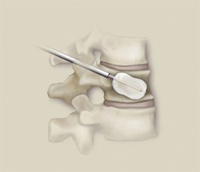Kyphoplasty
Kyphoplasty is a minimally invasive surgical procedure to treat vertebral compression fractures related to osteoporosis. Benefits include spinal deformity correction, significant pain relief, and, for many patients, the ability to resume a normal lifestyle.

How kyphoplasty is performed
Kyphoplasty is performed under local or general anesthesia. Small incisions are made in both sides of your back. Using image guided x-ray technology a narrow tube is threaded through the incision to the fractured vertebra. A special balloon, a bone tamp is inserted through the tube into the vertebra and gently inflated to help restore the vertebral body height.
Next, the bone tamp is removed and the space is filled with bone cement (polymethylmethacrylate, PMMA). The cement quickly hardens, repairs the fracture, and stabilizes and strengthens the vertebral body. Vertebral body height is restored and pain is relieved. The procedure takes about an hour for each fracture treated.
Potential benefits of kyphoplasty
Listed below are some of the benefits kyphoplasty offers.
- It is a minimally invasive procedure; small incisions, often a fast recovery
- Short hospital stay (sometimes outpatient)
- Most patients experience immediate pain relief
- Quickly able to return to normal daily activities
- No bracing is required
- Future spinal fracture may be avoided
- By stabilizing the fractured vertebra, the onset or worsening of severe spinal deformity is prevented
Possible risks, complications of kyphoplasty
All surgical procedures, including kyphoplasty, involve risks and complications.Some risks and complications are not related to the procedure, but to your general health. Your neurosurgeon will discuss all the procedure details, including potential risks that related to your specific case.
Post-operative care for kyphoplasty
- You may be discharged home as soon as one or two hours after your procedure. Some patients spend a night in the hospital
- You must have a friend or family member available to drive you home. Your procedure involved general anesthesia, and you cannot drive for at least 48 hours
- Keep the incision/puncture sites on your back clean and dry for several days
- Take care to avoid falling and other activities that put osteoporotic patients at risk for fracture (e.g., heavy lifting)
Closely follow the written instructions given to you at hospital discharge. These instructions include emergency contact information in case you develop problems before your follow-up appointment with your neurosurgeon.
You can learn more about kyphoplasty from the following sources:
|






